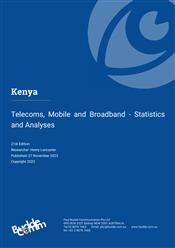Kenya Telecoms Market Report
Telecoms, Mobile and Broadband - Statistics and Analyses

Last updated: 27 Nov 2023 Update History
Report Status: Current
Report Pages: 238
Analyst: Henry Lancaster
Kenya’s telecom sector preps for sales and an IPPO
Kenya’s telecom market continues to undergo considerable changes in the wake of increased competition, improved international connectivity, and rapid developments in the mobile market. The country is directly connected to a number of submarine cables. Mombasa is the landing point for LIT’s newly completed East and West Africa terrestrial network, while Nairobi country serves as a key junction for onward connectivity to Ethiopia, the Arabian states, and the Far East. While the additional internet capacity has meant that the cost of internet access has fallen dramatically in recent years, allowing services to be affordable to a far greater proportion of the population, the telecom infrastructure remains woefully inadequate. Many millions of people lack any internet access, and what services are available are comparatively slow and expensive.
This poor situation poses significant challenges for the government’s digital transformation ambitions. There has been insufficient spectrum allocation to enable the MNOs to improve mobile network capacity, and while the launch of Starlink’s satellite broadband service in early 2023 may signify some relief for unserved people in rural areas, the high cost of hardware and access makes it unviable for many.
The government is channelling investment in a 100,000km fibre backbone, which is scheduled to be complete by the end of 2026. While thousands of governments offices, schools and health centres will access broadband as a result, much more work needs to be done if Kenya is to realise its potential as a regional ICT hub.
The incumbent fixed-line telco Telkom Kenya has struggled to make headway in this market, prompting a reorganisation in 2018 which included a sale and leaseback arrangement with its mobile tower portfolio. A further restructuring exercise in late 2020 was aimed at repositioning the company for the digital age, and to improve its ability to compete in the market.
Key developments:
- Safaricom opens east Africa’s first smartphone assembly plant, with a capacity of three million units annually.
- Regulator rejects calls to impose reduction in national roaming fees, claiming that fees should be set by commercial negotiation.
- Treasury recommends sale of Jamhuri Holdings’ 60% stake in Telkom Kenya to Infrastructure Corporation of Africa (ICA).
- Liquid Intelligent Technologies opens a new cable route between Nairobi and Ethiopia, providing Ethiopia with access to data centres and cloud services in Nairobi.
- Safaricom claiming to have signed up over 500,000 5G customers.
- Regulator sets mobile termination rate for two years from March 2024.
- Report update includes the regulator’s market data to June 2023, operator data to Q3 2023, updated Telecom Maturity Index charts and analyses, recent market developments.
Companies mentioned in this report:
Telkom Kenya, Jamii Telecom, Access Kenya (Dimension Data), Kenya Power and Lighting Company (KPLC), Kenya Pipeline Corporation (KPC), Wananchi, Safaricom, Bharti Airtel, MTN, Liquid Intelligent Technologies (Liquid Telecom), Essar Telkom Kenya, Mobile Pay (Tangaza Pesa), Zioncell Kenya, Finserve Africa (Equitel), Kenya Data Networks (KDN), Jamii Telecom, SimbaNet, Africa Online, Access Kenya (Dimension Data), Wananchi Online, Swift Global, Internet Solutions Kenya (InterConnect), Gilat Satellite Networks, Afsat Communications, Inmarsat, Indigo Telecom (Thuraya), Nation TV (NTV)
Related Reports
- Africa - Fixed Broadband Market - Statistics and Analyses
- Africa - Mobile Infrastructure and Mobile Broadband
- Africa - Mobile Network Operators and MVNOs
- Nigeria - Telecoms, Mobile and Broadband - Statistics and Analyses
- Ghana - Telecoms, Mobile and Broadband - Statistics and Analyses
- Côte d Ivoire (Ivory Coast) - Telecoms, Mobile and Broadband - Statistics and Analyses
- Algeria - Telecoms, Mobile and Broadband - Statistics and Analyses
- Somalia - Telecoms, Mobile and Broadband - Statistics and Analyses
- Mozambique - Telecoms, Mobile and Broadband - Statistics and Analyses
- Tanzania - Telecoms, Mobile and Broadband - Statistics and Analyses
Share this Report
TMT Intelligence
A platform to scale your intelligence tasks
Monitor critical insights with our AI-powered Market Intelligence Platform gathering and analyzing intelligence in real time. With AI trained to spot emerging trends and detect new strategic opportunities, our clients use TMT Intelligence to accelerate their growth.
If you want to know more about it, please see:
Research Methodology
BuddeComm's strategic business reports contain a combination of both primary and secondary research statistics, analyses written by our senior analysts supported by a network of experts, industry contacts and researchers from around the world as well as our own scenario forecasts.
For more details, please see:
More than 4,000 customers from 140 countries utilise BuddeComm Research
Are you interested in BuddeComm's Custom Research Service?
Hot Topics
News & Views
Have the latest telecommunications industry news delivered to your inbox by subscribing to BuddeComm's weekly newsletter.